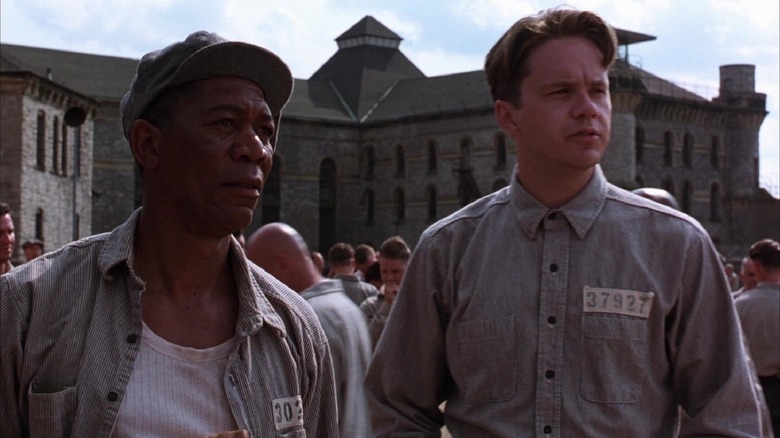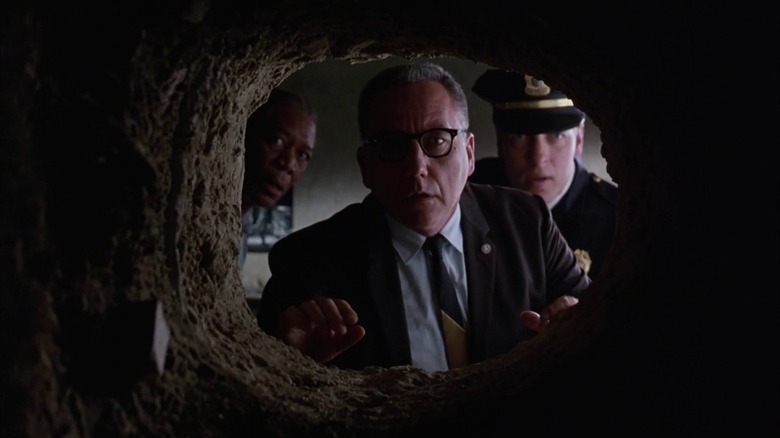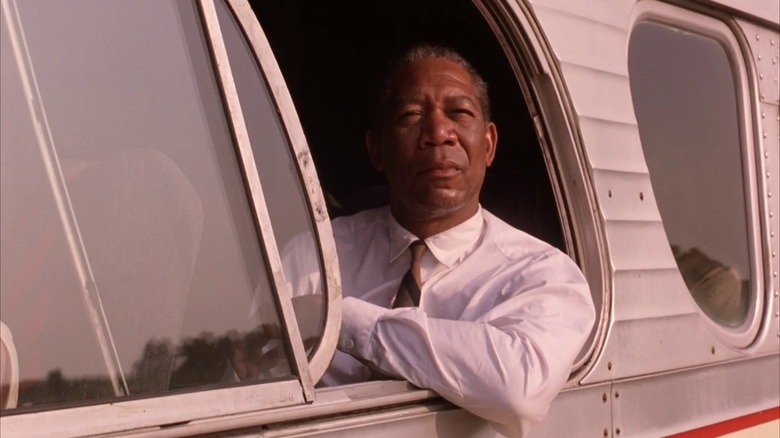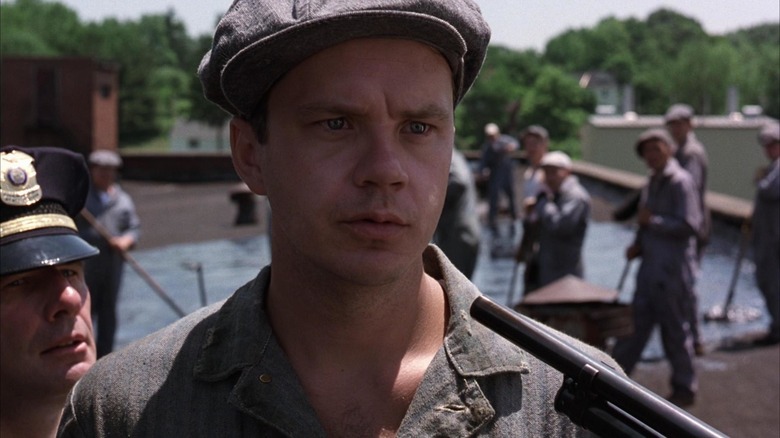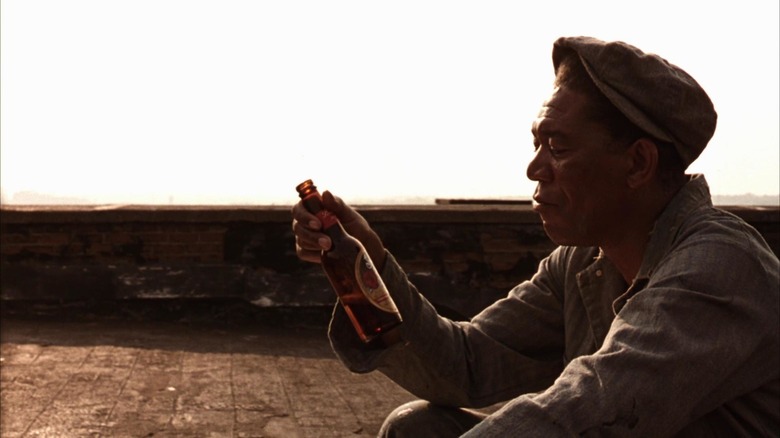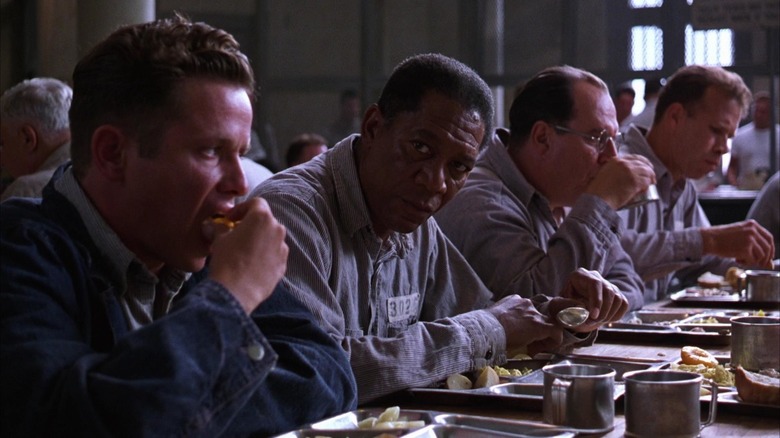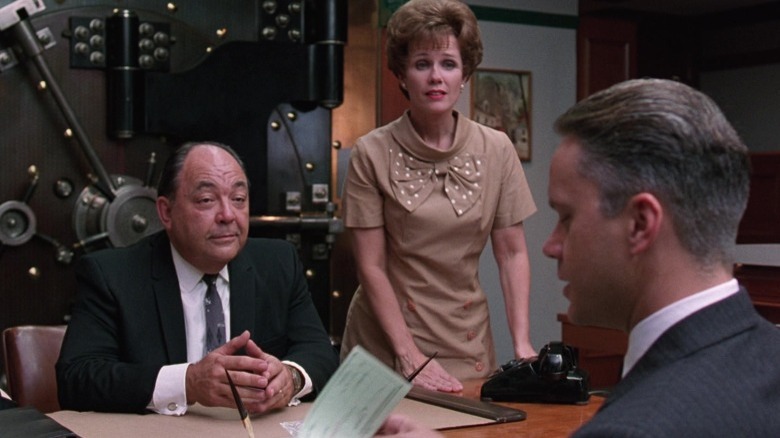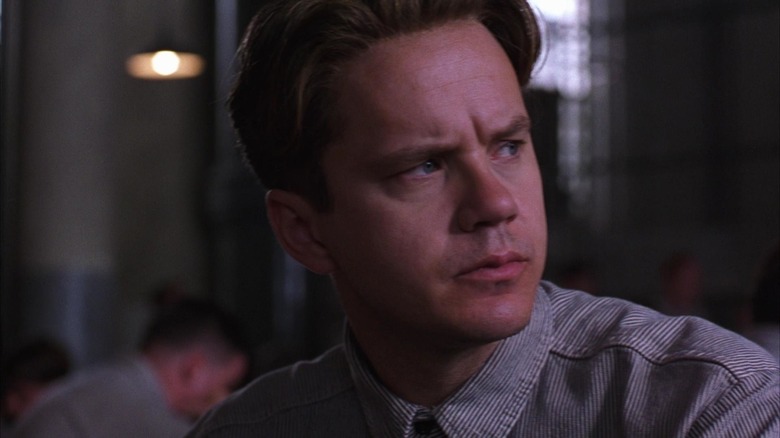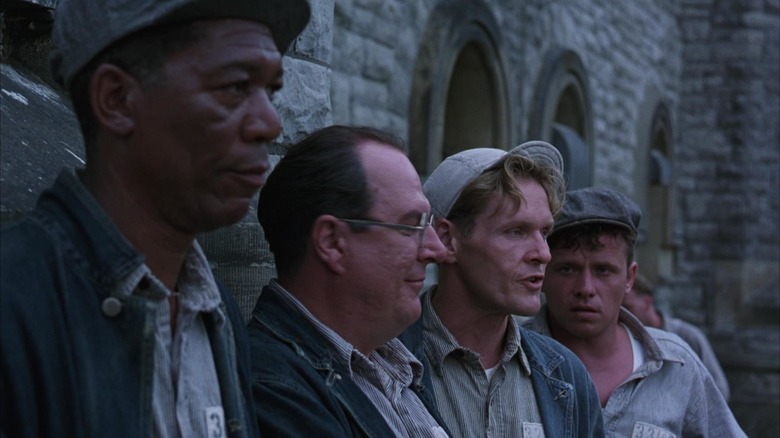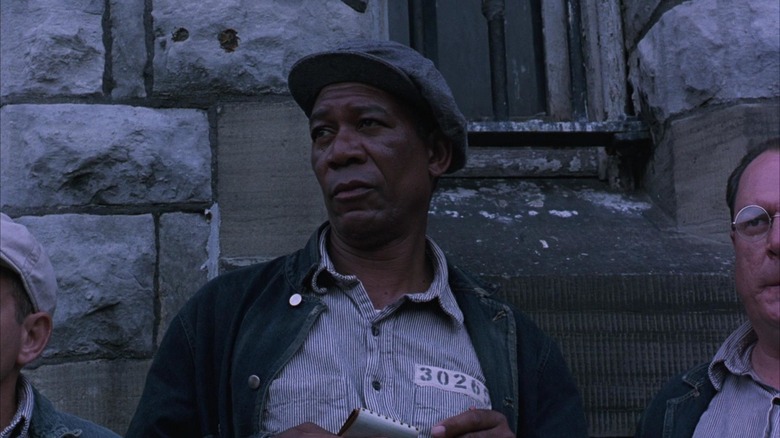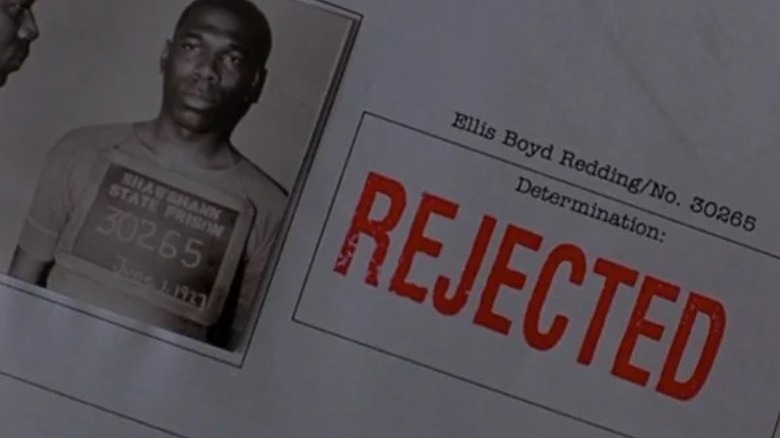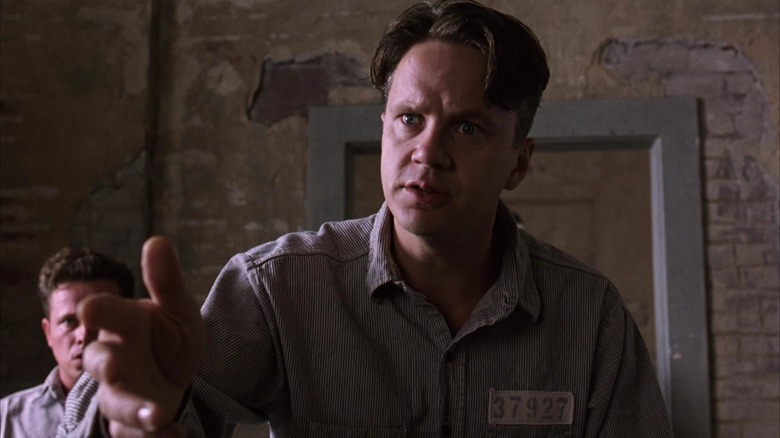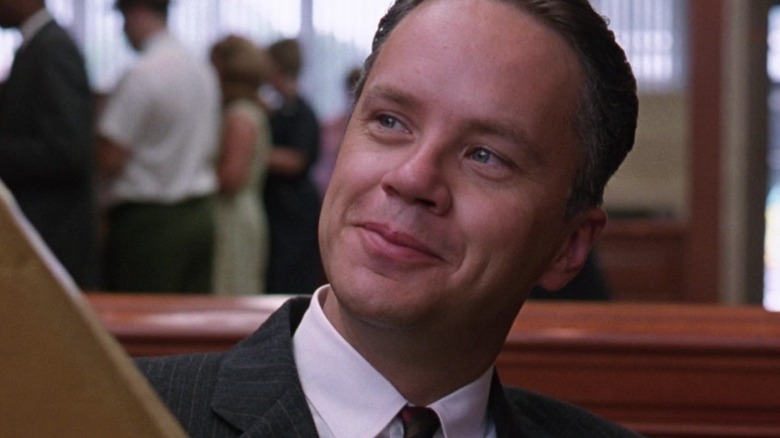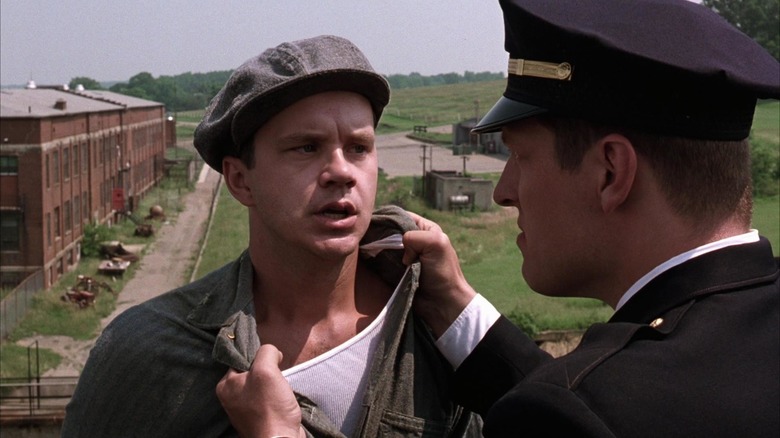Things In The Shawshank Redemption You Only Notice After Watching It More Than Once
Widely considered to be one of the greatest films ever made, "The Shawshank Redemption" has earned its place in cinema history. An adaptation of the Stephen King novella "Rita Hayworth and Shawshank Redemption," the film proved to be something of a financial failure when it first hit cinemas in 1994. However, it later won numerous Academy Awards nominations and quickly developed a large audience thanks to continual broadcasts on television.
The film charts the life of Andy Dufresne (Tim Robbins), who is wrongly sentenced to life in prison for the murder of his wife and her lover. While incarcerated, he meets Red (Morgan Freeman) and establishes a role within the prison for himself, earning the respect of his fellow inmates and the warden.
While it is a story that many people will be familiar with, there are plenty of hidden clues, references, and interesting details to look out for. Here are the things in "The Shawshank Redemption" that you only notice after watching it more than once.
The warden makes an unknowing reference to how Andy escapes
"The Shawshank Redemption" is full of small references and clues that hardly anyone would notice on first viewing, but on subsequent rewatches, you'll be wondering how they passed you by. One of these is a very early hint about exactly how Andy would escape the prison. At one point, the contents of Andy's cell are being tossed around by Captain Hadley (Clancy Brown) and Warden Norton (Bob Gunton) as they check for contraband.
The room is completely trashed, with Andy's belongings on the floor, the bed flipped over, and the pair coming close to discovering the secret tunnel he has been digging in the wall. When the warden finds Andy's Bible, the two discuss their faith and then talk about their favorite verses from the good book. After this brief interaction, the warden hands the Bible back to Andy and tells him that "salvation lies within."
This is a clear clue that Andy has in fact hidden his rock hammer inside the Bible — something that the warden inadvertently references when he gives it back to Andy. As well as the words being found in the Bible, Andy's salvation — that is the tool he will use to escape — also lies hidden within the pages.
Red inadvertently predicts Andy's method of escape
Escaping from Shawshank State Penitentiary is never far from Andy's mind, and there is another brief quote from a character in "The Shawshank Redemption" that offers a clue to the way he eventually breaks out. This hint will probably have gone completely unnoticed the first time around but if you listen carefully when rewatching the movie then you might well realize the significance of what Red says to Andy when the two are talking later in the film.
While having a conversation just before his escape attempt, Andy talks to Red about his plans for when he gets out of prison. The two prisoners speak about the future and Andy reveals that he wants to travel to Mexico and live in the country when he is on the outside. Red is unsympathetic to his friend's desires and tells him that he shouldn't torture himself with such frivolous thoughts as they are nothing but "s****y pipe dreams" — something that is practically impossible and will likely never happen.
When Andy does escape from the prison it is via a method that is referenced in Red's dialogue. He crawls through hundreds of yards of human excrement in a sewage pipe — a "s****y pipe" if you will — and Andy's dreams of escape finally come true.
There is a connection between this film and Goodfellas
Just a few years before "The Shawshank Redemption" was released, another all-time classic also hit cinema screens worldwide. Martin Scorsese's "Goodfellas" starred Robert De Niro, Ray Liotta, and Joe Pesci" as three mobsters and proved to be a financial and critical success, winning numerous awards. "Goodfellas" is so highly regarded that it makes a lot of sense that other filmmakers would look to it for inspiration, but "The Shawshank Redemption" may not be an example that would immediately jump out to most people as the genre is very different.
Yet, if you look closely there are numerous references to the film and indications that Frank Darabont took inspiration from "Goodfellas" when making "The Shawshank Redemption." Darabont spoke about this in an interview with Creative Screenwriting and mentioned that his film's use of voiceover – with Red narrating Andy's journey in prison — was directly inspired by Scorsese's film. The film continued to inspire Darabont during the shoot with the director commenting, "my talisman in Ohio was my tape of 'Goodfellas.' I took it with me, and on weekends ... I'd sit there totally blown-out and depressed, and I'd pop in 'Goodfellas' and get inspired again."
The two films also involve a significant amount of time passing as they progress. Both of them involve a passage of several decades, with "The Shawshank Redemption" taking place over the course of 20 years while "Goodfellas" sees a story that skips ahead, stopping only at the most critical moments in the lives of the characters — a trait that both movies share.
Red's Irish joke is a callback to the character in the original story
Anyone who has seen "The Shawshank Redemption" will likely appreciate the performance of Morgan Freeman. The celebrated actor plays the character Red, one of the other inmates in Shawshank State Penitentiary and someone who is well respected by the other prisoners. Red becomes fast friends with Andy and the two grow closer and closer throughout the film. However, the character is very different in the original Stephen King novella. In that story, Red is a white Irish man but has the same role as the prison fixer who sources the rock hammer for Andy.
The character's name makes sense in the story but Red doesn't match quite as well for the depiction of him in the film. It is revealed at one point that his real name is actually Ellis Boyd Redding, giving a clear reason for why he uses Red as a nickname. However, when Andy asks him about his moniker, Red simply replies "Maybe it's because I'm Irish" before walking away. This cheeky joke would be lost on the vast majority of viewers but if you know about the original story then it's a wonderfully subtle and knowing reference.
Despite being set in Maine, no one speaks with a New England accent
Of the more than 80 novels that Stephen King has written over the course of his career, there is usually one main constant: The vast majority of them are set in the state of Maine, the place of the author's birth and the area where he still lives. It is perfectly understandable, then, that the story "Rita Hayworth and Shawshank Redemption" takes place in Maine just like most of his other stories. When it came to adapting the novella for film, director Frank Darabont chose to keep the setting the same so that the movie also happens entirely in Maine.
For most people that wouldn't be an issue and the setting wouldn't raise any eyebrows. However, if you have watched "The Shawshank Redemption" multiple times then something could have jumped out as unusual. That's because none of the characters in the film speak with a New England accent, despite the fact that a good deal of the characters in the prison should be from Maine. The only character with the hint of an accent is the warden but even that is only very slight. There should be a lot more individuals speaking as if they are actually from the area, but this isn't something that detracts from the story in the finished film.
There are only two female speaking roles in the entire film
Even those who have seen the classic drama once or twice might not realize that there is a distinct lack of women throughout the entire film. In many ways, it shouldn't be all that surprising that most of the characters in "The Shawshank Redemption" are men with the vast majority of the action taking place in Shawshank State Penitentiary — a prison for male inmates. This means that all of the prisoners are men, and the staff are also male to ensure that they stay safe, leaving very little opportunity for speaking roles for women. Even Andy's wife — who is shown during a flashback sequence at the start of the movie — doesn't talk during the brief time she is on screen.
There are just two female speaking roles in "The Shawshank Redemption" for those who are looking closely. One is the bank teller — played by Claire Slemmer — who speaks to Andy after he escapes from prison and requests some cash, while the other is a customer — played by Dana Snyder — who tells Brooks to double bag her shopping when he is working in the store.
The maggot fed to the crow was not real
Brooks (James Whitmore) is one of the few prisoners in "The Shawshank Redemption" — outside of Andy and Red — who is given significant screen time. One of the oldest inmates in Shawshank State Penitentiary, he is put in charge of the library and later befriends Andy when he is transferred to work with the books as well. The two bond over their love of fiction and the fact they are both highly educated, with Brooks revealing that he is caring for an injured crow called Jake that has a damaged wing. When Andy finds a maggot in his prison food, Brooks asks if he can have the insect so he can feed it to Jake.
It might not have been immediately obvious to viewers but the maggot itself was not a real living creature. The American Society for the Prevention of Cruelty to Animals objected to an insect being fed to the bird entirely for filming purposes as they don't allow any living creatures to be killed for a movie. According to Humane Hollywood, this maggot was actually fashioned from baby food to give it the appearance of an insect larva and make it edible for the crow, which was carefully placed in the actor's pocket by an animal handler.
Nobody seems to age
"The Shawshank Redemption" takes place over quite a long period of time. According to Red, Andy first arrives in Shawshank State Penitentiary in the year 1947 and doesn't escape the walls of the facility until 1966. That means that the entire film takes place over the course of some 19 years, not including the various flashbacks that show events prior to Andy being incarcerated. This passage of time is made perfectly clear to the audience as well, so it isn't like the filmmakers are trying to disguise the fact that so many years have passed.
But despite almost two decades passing during the story, none of the characters in "The Shawshank Redemption" show any signs of aging whatsoever. Red, Andy, and the others all look the same near the conclusion of the film as they do right at the start of the action. They should have aged by some 20 years in that time and at least demonstrate some evidence that they are now much older than they were, yet that simply is not the case in this film.
Red's cell number is a reference to The Shining
In Stephen King's novels, the number 217 has appeared several times. It was most famously the number of the guest room at the Overlook Hotel where Lorraine Massey had died — an event that played an integral part in the narrative of "The Shining." When Stanley Kubrick adapted the book to the hit film in 1980, however, he didn't keep the room number the same but rather changed it to 237 seemingly at the request of the lodge so that visitors would not want to avoid the apparently cursed room in real life (per Far Out Magazine).
A callback to this important number is made in "The Shawshank Redemption," although it is only briefly mentioned and could easily be missed by anyone watching the movie for the first time. Red's cell in Shawshank State Penitentiary is numbered 237, revealed when the guards complete a roll call at the start of the day. There's little doubt that this is just a coincidence and was intended as an Easter egg for those who are big fans of King's wider work.
Red's mugshot is not just any person
As "The Shawshank Redemption" progresses, we find out more about the past of some of the characters. One consistent theme that is present throughout the film is Red attending a parole hearing to determine whether he has rehabilitated and is fit to re-enter society. Over the course of the two decades that are portrayed in the movie, Red attends three different parole hearings before he is finally approved and allowed to leave Shawshank State Penitentiary after spending 40 years behind bars.
During these hearings, a folder showing Red's prison file is on display. It showed the "rejected" stamp mark and information about the character. This includes a photograph of Red in his youth when he was first put in prison. The picture used isn't just a random younger man but someone that looks very like the actor Morgan Freeman and there's a very good reason for that. The photograph is actually of Alfonso Freeman, Morgan's son who also plays a convict in the prison during the early parts of the film.
Close-ups of Andy's hands aren't Tim Robbins
It is not unusual for directors to occasionally have a role in their films. This may involve a director having a cameo in a television show or movie as well as actually appearing in a film to perform a specific action. That's exactly what Quentin Tarantino did in both "Kill Bill" and "Inglourious Basterds" when he felt that he couldn't trust someone else to pull off specific scenes. In both of these cases, actors needed to be choked for it to seem realistic, with the director feeling that only he could pull off such a delicate process so it is his hands you see in the final edit (via Deadline).
A similar thing happens in "The Shawshank Redemption," with director Frank Darabont acting as a hand double for Tim Robbins' character. According to the DVD commentary for the film (via CinephiliaBeyond), the director used his own hands for insert shorts when Andy was handling a revolver or any other close-ups of the character's hand as he felt that he could perform the required motions more accurately than Robbins could. Of course, it would also save time and effort to simply perform the actions himself but only the most eagle-eyed viewers would ever notice the hands are different.
There is another reference to previous Stephen King novels
Along with the not-so-subtle reference to "The Shining," "The Shawshank Redemption" also includes a variety of other Easter eggs related to Stephen King novels or film and television adaptations of his work. One of the more obvious is the alias that Andy uses while doing the taxes of the warden.
In King's original story, the alias used is Peter Stevens and it gives Andy the opportunity not only to hide his illicit activities on behalf of the warden but later also to withdraw the hidden money from several banks after he escapes from prison.
In the film, Andy invents the name Randall Stevens — which is a nod to the supernatural villain Randall Flagg from various novel series written by King, including "The Stand" and "The Dark Tower." Frank Darabont admitted he changed the original name from Peter Stevens in homage to the author without telling the legal team or the rest of the crew (via Cinema Blend).
Tim Robbins is hardly ever standing up straight
Few people would have complaints about Tim Robbins' performance in "The Shawshank Redemption." In fact, it would be difficult to imagine anyone else taking on the role of Andy in the film, making it an almost perfect price of casting — especially when you consider the other fantastic actors who are part of the movie as well.
However, having Robbins portray Andy did throw up some rather interesting problems for director Frank Darabont. The actor is significantly taller than most people, standing at an impressive 6 feet 5 inches (1.96 m). That makes him around four inches taller than his co-star Morgan Freeman and a full head larger than most of the cast. With Andy not meant to be an especially imposing figure, the filmmakers were required to make it seem as if Robbins was actually shorter than he really is (via The Big Lead).
The way this was achieved is remarkably simple and something the audiences likely would pay very little attention to, at least on the first viewing. Darabont just had Robbins rarely stand up straight so that almost every scene involving Andy sees the character either sitting down or leaning to one side. This gave the illusion that he was actually a similar height to everyone else.
